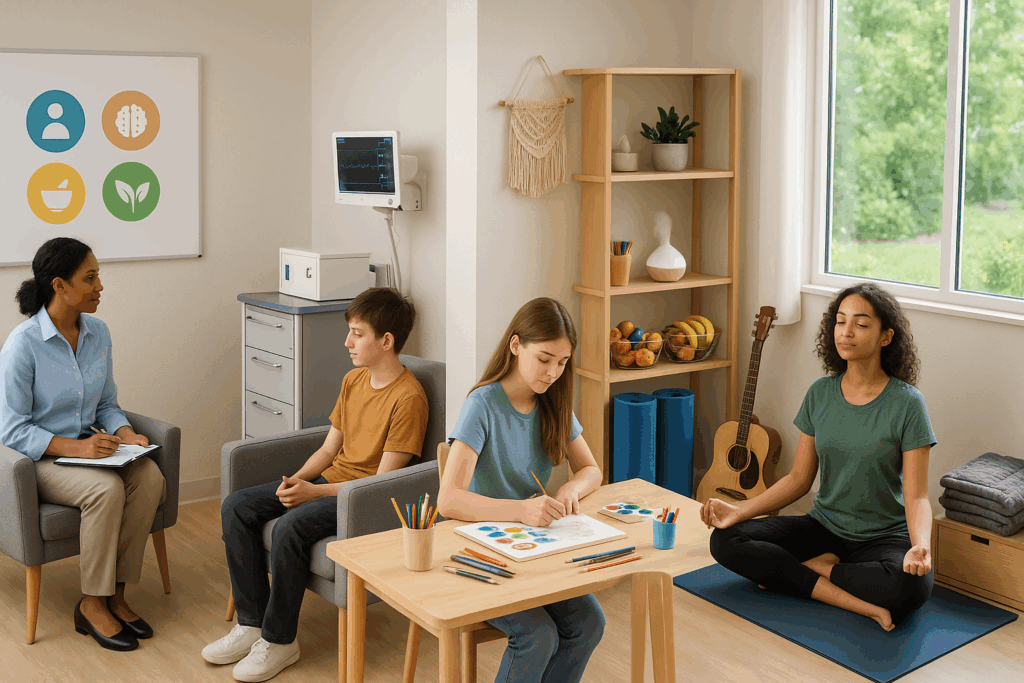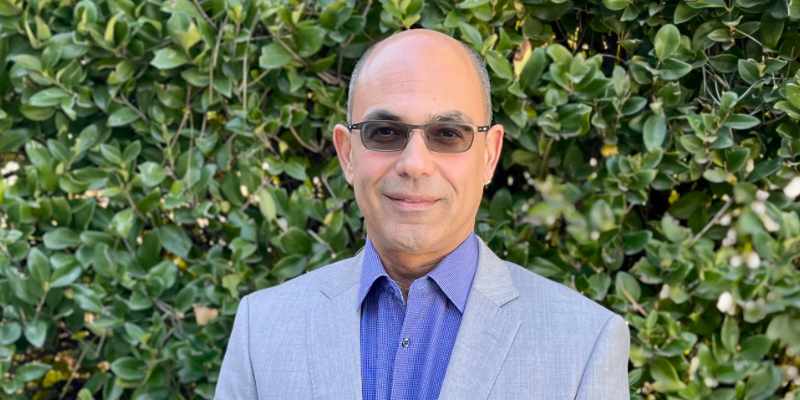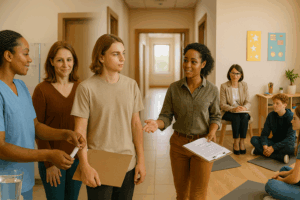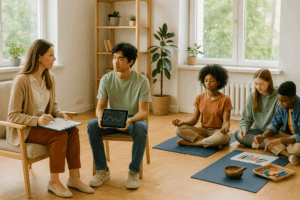When a teen has both a mental health condition and a substance use disorder, comfort and safety matter. Amenities are not a luxury for looks. The right environment can lower stress, improve sleep, and help teens take care of themselves. Good design and services, such as quiet bedrooms, access to nature, movement spaces, creative rooms, and a strong nutrition program, can support therapy and medication plans. Research shows that integrated treatment for co-occurring disorders works best. A calm, teen-focused setting makes that plan easier to follow. Programs that are psychiatrist-led and adolescent-only can pair these amenities with evidence-based care across levels like detox, residential, PHP, and IOP when clinically appropriate. BNI Treatment Centers provides a boutique, home-like environment for ages 12–17 with academic support and a full continuum for dual diagnosis in Agoura Hills and Calabasas near Los Angeles. In this guide, you will learn how amenities support recovery, which features have research behind them, and what to look for when comparing teen programs. Keep reading to build a safe, seamless plan that helps your family breathe again.
Why amenities belong in a clinical plan for dual diagnosis

Amenities are tools. They set the stage for therapy, medication management, and family work. For teens with co-occurring disorders, the space itself can lower arousal, reduce triggers, and make it easier to learn new skills. A structured, supportive “milieu” is a well-studied part of youth psychiatric care. The goal is to create an environment that fosters healing through routine, safety, and positive interactions with peers and staff.
Integrated treatment is the standard for co-occurring disorders. That means one team treats both the mental health condition and the substance use disorder with a single plan. Amenities cannot replace that plan. They can make it easier to follow by improving sleep, mood, and daily engagement. National public health and research sources emphasize the importance of concurrent, integrated care for co-occurring conditions in youth and young adults.
- The right setting supports focus, safety, and skill practice.
- Integrated care is the backbone. Amenities help that care land and last.
- Teens require adolescent-specific spaces and routines that align with their developmental needs.
Sleep-friendly design: dark, quiet, and steady
Sleep is a pillar of recovery. Poor sleep raises the risk of depression, anxiety, and relapse in adolescents. A sleep-supportive environment can enhance mood, attention, and academic performance. Features include dark, quiet bedrooms, consistent lights-out routines, and comfortable, clean bedding. Research links sleep problems with higher depressive and anxiety symptoms in teens. In contrast, better sleep hygiene is associated with improved mental health and cognition.
For families comparing programs, ask how the setting supports healthy sleep. Look for structured evening routines, device limits at night, and staff who coach sleep habits. These details help teens feel calmer and more in control during care.
- Dark, quiet rooms and consistent routines improve sleep quality.
- Better teen sleep is associated with stronger mood and cognitive skills.
- Programs should teach simple sleep skills teens can use at home.
Nature and calming outdoor spaces
Spending time in nature can help reduce stress and lift mood in children and adolescents. Even brief exposure to natural scenes can help teens feel more relaxed and focused. On-site gardens, outdoor seating, and safe walking areas give teens a place to reset between sessions. Reviews and experiments point to positive links between nature exposure and mental well-being in youth.
For individuals with dual diagnosis, lower stress means fewer triggers and improved learning. Outdoor areas also support group activities that foster social connection without the use of screens or substances. Simple design choices, such as shaded seating and quiet paths, matter.
- Exposure to nature is associated with improved mood and attention in adolescents.
- Outdoor spaces help regulate stress between therapy sessions.
- Look for secure, comfortable, and easy-to-access outdoor areas.
Movement and fitness spaces
Exercise is a strong add-on for adolescent depression and anxiety. Movement improves mood, sleep, and self-regulation. A safe gym or movement room makes it easy to include short activity blocks in the day. Trials and reviews show that exercise reduces depressive symptoms in young people and can help in inpatient settings.
In dual diagnosis care, exercise also supports craving management and stress tolerance. Programs can teach brief routines that teens can bring back to school and home. Activities do not need to be intense. The key is consistency and safety.
- Exercise reduces depressive symptoms in teens.
- Short, structured workouts help emotion regulation in hospital settings.
- A simple daily plan beats sporadic, intense efforts.
Creative arts rooms and makerspaces
Art therapy and creative spaces provide teens with a nonverbal means to process their feelings, trauma, and grief. For many adolescents, words are not enough. The evidence base for art therapy in youth mental health is growing, with reviews finding benefits across settings and conditions. A dedicated, well-lit art room stocked with safe materials supports this work.
Creative spaces also build motivation. Teens often show up more fully when therapy includes hands-on activities. Pairing art with skills from CBT or DBT can help teens tolerate tough emotions while staying engaged.
- Art therapy is an effective and acceptable approach for many youth in distress.
- Creative rooms keep teens engaged and help build their expressive skills.
- Ask about materials, safety, and how art ties to core therapy goals.
Nutrition-forward kitchens and dining
Food affects mood. Teens need steady meals to support focus, sleep, and medication timing. While diet is not a cure, evidence suggests that overall dietary patterns are linked to mental health outcomes. Families can ask how programs approach balanced meals, hydration, and snacks that match teens’ needs. National coverage highlights links between nutrient-dense patterns and improved mood
The best programs keep meals simple, balanced, and predictable. They also make space for cultural and medical needs. Teens who feel cared for at meals are more likely to engage in therapy and schoolwork during care.
- Consistent, balanced meals support a healthy mood and energy levels.
- Hydration and snack timing are crucial for maintaining focus and optimal activity blocks.
- Nutrition should complement, not replace, evidence-based treatment.
Private, home-like spaces that feel safe
Privacy and safety lower anxiety. Semi-private or private rooms, clean bathrooms, and calm common areas help teens settle. A home-like setting can help soften the stigma and make it easier to discuss difficult topics. The therapeutic milieu literature describes how environment, routine, and relationships work together to support change.
Programs serving adolescents should be designed for teens, not adults. Clear house rules, structured quiet times, and predictable schedules help teens regulate. These design choices become part of the treatment, not an afterthought.
- Calm, home-like spaces reduce arousal and stigma.
- Predictable routines help teens feel safe enough to do the work.
- Ask how spaces are supervised and how privacy is balanced with safety.
Tech boundaries and quiet lounges
Phones and social media can trigger cravings, anxiety, and sleep loss. Amenities that strike a balance between connection and limits help teens focus. Quiet lounges, device check-in times, and screen-free activities support a calm and learning environment. Sleep research shows that less evening screen use can improve teen sleep quality and mental health.
A good policy is clear, kind, and consistent. Teens know when they can check messages and when it is time for rest or treatment. This structure helps families later at home.
- Evening device limits improve sleep and mood.
- Quiet lounges offer transitions between groups and school blocks.
- Ask for written tech policies and how staff enforce them with care.
Academic nooks and study support
Keeping school on track helps lower stress and protect self-esteem. Dedicated study areas and academic coaching are key amenities in teen programs. BNI provides on-site academic support to help teens continue coursework and plan for reintegration with school teams. Linking treatment and school reduces dropout risk and supports smoother transitions.
Families can ask about daily study time, teacher communication, and simple plans for deadlines. Quiet, well-lit study nooks reduce distractions and help teens practice routines they will use at home.
- On-site academic support reduces fear of falling behind.
- Coordinated school plans protect gains during step-downs.
- Request a named school contact and weekly progress reports.
Amenities work best inside an integrated, teen-only model.
Amenities are helpful when they are situated within a strong clinical framework. For adolescent dual diagnosis, one team should treat both conditions in one plan. This reduces mixed messages and keeps goals aligned. Reviews and federal guidance describe integrated treatment as the most effective approach for co-occurring conditions.
BNI Treatment Centers is psychiatrist-owned and led, serves only adolescents ages 12–17, and offers a continuum that includes medical detox, residential inpatient, PHP, and IOP, with academic support and a boutique, home-like environment in Agoura Hills and Calabasas. This structure enables amenities to support real clinical work, rather than distracting from it.
- Integrated care, with a single team and plan, drives better outcomes.
- Adolescent-only settings match development and school needs.
- Amenities should serve the treatment plan, not the other way around.
How to compare programs: a parent checklist
Environment and safety
Ask to see sleeping areas, bathrooms, common rooms, and outdoor spaces. Look for clean, calm, and teen-appropriate design. Ask how privacy is balanced with safety and how the milieu supports regulation.
Integrated, adolescent-specific care
Confirm that one team treats both mental health and substance use in the same plan. Verify that the program is built for ages 12–17 and is led by psychiatrists with adolescent expertise.
Movement, nature, creativity
Tour any gym or movement rooms, outdoor areas, and creative spaces. Ask how often teens use them and how they connect to therapy goals.
Sleep and tech routines
Review lights-out times, device policies, and evening structure. Ask about sleep coaching and what happens if a teen cannot sleep.
Academics
Request details on study time, teacher contact, and grading plans. BNI lists on-site academic support for adolescents. Ask how plans adjust during step-downs.
- Choose programs that show how each amenity supports a clinical goal.
- Look for clear schedules and warm, respectful staff.
- Verify levels of care and how transitions work for teens.
How BNI’s setting supports teen recovery
Families in Greater Los Angeles and those willing to travel often look for a safe, boutique setting with medical leadership. BNI Treatment Centers presents a psychiatrist-led, adolescent-only continuum for ages 12–17 with medical detox, residential inpatient, PHP, and IOP, plus on-site academic support. The program emphasizes a small, home-like environment designed for teens. Facility tours showcase calm residential settings in Agoura Hills and Calabasas, offering a high-quality, individualized experience for adolescents.
When you speak with admissions, you can ask how specific amenities support your teen’s goals. You can also verify private commercial insurance benefits early. BNI states that it works with many major commercial plans and provides benefits checks, and the site lists locations and age groups served.
- Psychiatrist-led care in a home-like, adolescent setting.
- Clear levels of care with academic support for ages 12–17.
- Tours and program pages for Agoura Hills and Calabasas.
Sources cited inside the guide
- Integrated and co-occurring treatment guidance: SAMHSA and peer-reviewed reviews on integrated care for co-occurring disorders.
- Therapeutic milieu and environment: Research on psychiatric milieu and healing environments.
- Sleep and teen mental health: Reviews and reports linking sleep quality to mood and cognition in adolescents.
- Nature exposure: Reviews and experiments on nature’s impact on youth well-being and attention.
- Exercise: Systematic reviews and trials on exercise for adolescent depression and anxiety.
- Creative arts: Reviews on art therapy effectiveness with young people.
- Academic support: BNI academic support page and program structure for adolescents.
- Program fit and locations: BNI main site and facility tour pages for Agoura Hills and Calabasas.
When you are ready to take the next step
Your teen deserves a setting that feels calm, respectful, and designed for growth. If you are exploring adolescent-only, psychiatrist-led care in Los Angeles, BNI Treatment Centers offers a home-like environment with clear paths across detox, residential, PHP, and IOP for ages 12–17, plus on-site academic support. You can tour the facilities and verify private insurance benefits to see how the space and the plan can work for your family.




